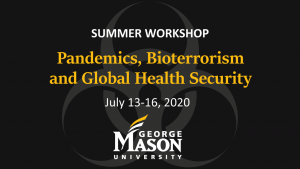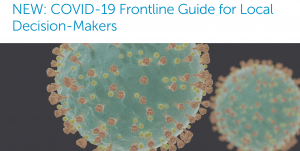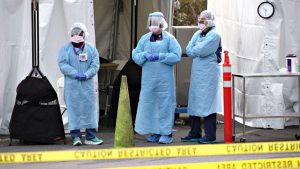Not even a pandemic can stop your weekly dose of biodefense news. We’d like to take a moment to thank all who are working in COVID-19 response – from healthcare workers to those in lab, public health, and everyone working in essential services, thank you for all you do!
 Summer Workshop on Pandemics, Bioterrorism, and Global Health Security
Summer Workshop on Pandemics, Bioterrorism, and Global Health Security
Are you registered for the summer workshop yet? From July 13-16, 2020, GMU Biodefense will be hosting a three and a half-day workshop on all things global health security. Leaders in the field will be discussing hot topics like COVID-19, pandemic preparedness, vaccine development, medical countermeasures, synthetic biology, and healthcare response to COVID-19. This is also a great networking opportunity as past participants come from a range of government agencies, NGOs, universities, think tanks, and foreign countries. Don’t miss out on the early-bird discount for this immersive workshop – you can register here.
Updating the CWC: How We Got Here and What is Next
Make sure to check the April 2020 edition of Arms Control Today as GMU Biodefense Graduate Program Director (and CW/BW guru) Dr. Gregory Koblentz has a new article with Stefano Costanzi. Russia’s attempted assassination of Sergei Skripal in Salisbury, United Kingdom with a Novichok nerve agent in March 2018 triggered the first-ever update of the Chemical Weapons Convention (CWC). In November 2019, parties to the CWC agreed to add Novichok agents, as well as carbamate nerve agents, to the Schedule 1 list of chemicals subject to the treaty’s most stringent declaration and verification requirements. The article describes the process that led to the first ever modification to the treaty and offers some recommendations for strengthening the treaty’s coverage of these nerve agents. For more detailed technical information on Novichok agents and further background on the Schedule 1 revision process, please refer to our article, “Controlling Novichoks After Salisbury: Revising the Chemical Weapons Convention Schedules,” which was published in The Nonproliferation Review in September 2019.
An Infected Economy: Acute & Chronic Economic Considerations of COVID-19
GMU Biodefense doctoral student Rachel-Paige Casey is tackling the painful economic and financial aspects of COVID-19 in her commentary, An Infected Economy, which you can read here. “The commonly recited statement that COVID-19 knows no bounds is not confined to its effects on individual or population health; it is also the instigator of our current and growing economic woes. Prior to COVID-19, it was well-established that an outbreak of a reemerging or novel disease with high communicability would ravage the US economy, along with global economy. A combination of industry shut downs to reduce disease transmission and panic-induced risk averse behavior among consumers and producers turns a pandemic into a pestilence for the economic health of countries and their people. Just as the high probability of a pandemic was foreseen so to were the economic effects of such an event. As the Washington Post stated, COVID-19 is no black swan, nor is it an event for which we were not given warning shots.” Keep reading here.
ASPR TRACIE COVID-19 Resources
ASPR has now released a Novel Coronavirus Resource Page which provides people with vetted resources to tackle the ongoing pandemic. Within the site, people can find planning resources, federal websites, technical assistance requests, ASPR TRACIE-developed resources, and more. This is a great resource for preparedness efforts and can help a wide range of people looking to enhance preparedness across multiple sectors. They also encourage sharing of info – “If you have any COVID-19 promising practices, plans, tools, or templates to share with your peers, please visit the ASPR TRACIE Information Exchange COVID-19 Information Sharing Page (registration required) and place your resources under the relevant topic area.”
 A Frontline Guide for Local Decision-Makers
A Frontline Guide for Local Decision-Makers
To help unwind the web of confusion and chaos, a COVID-19 Frontline Guide for Local Decision-Makers was drafted by experts from the Nuclear Threat Institute, the Center for Global Health Science and Security at Georgetown University, and Talus Analytics. The Guide outlines 7 key objectives for local decisionmakers:
- Activate Emergency Operations Center and establish a whole-of-community incident management structure
- Understand the real-time spread of COVID-19 in your community
- Slow and reduce transmission
- Focus protection on high-risk groups
- Reinforce and expand health system surge capacity to sustain healthcare operations and avoid high mortality
- Expand risk communication and community engagement
- Mitigate economic and social consequences
They also provide several questions regarding progress to track an area’s improvement in response measures. The contributors for the Guide encourage and welcome feedback. The Guide is available here.
Policy vs. Pandemics: Polarization and Public Health Emergency Preparedness
Did you miss the virtual event last week? Check out our YouTube channel here for the recording. Last week, Dr. Nathan Myers, author of Pandemics and Polarization: Implications of Partisan Budgeting for Responding to Public Health Emergencies, gave a virtual presentation at GMU. Dr. Myers’ book was written to be a wakeup call about the politicization of preparedness crippling our efforts to prepare for and respond to pandemics. The book focuses on surveillance, coordination, and countermeasures as key tools for pandemic preparedness and response. Dr. Myers’ book is available here in hardcover and Kindle formats.
Cautionary Results from the Dark Winter Simulation
In 2001, the now-called Center for Health Security at Johns Hopkins University and the Center for Strategic and International Studies designed and hosted a tabletop exercise, “Dark Winter.” Participants in the simulation included US officials and senior policymakers, and it was conducted to assess how senior leaders would respond to a biological weapons attack. The agent in Dark Winter is smallpox. The lessons drawn from the simulated pandemic foreshadowed the struggles we are currently facing with COVID-19. Participants questions and concerns from the exercise ran the gamut. How many Americans are infected? How many are exposed? Where are they located? What health resources are available to treat them? Should any health resources be voluntary or required? Should these resources be provided by local, statewide, or national entities? How should they be enforced? Who will staff pop-up clinics and hospitals? retired Air Force Col. Randall Larsen, one of the designers of the exercise, described as “uncannily accurate.” Exercises like Dark Winter are valuable tools that illuminate important gaps for when an event occurs in reality. Similar to Crimson Contagion, a USG-organized pandemic exercise held last year, which we covered here, these events are indicators for overall pandemic preparedness and response. Hopefully, these lessons will be better heeded as we continue to respond to COVID-19 and as we prepare for the next outbreak. The full article is available here.
BioD Student Spotlight: HyunJung Kim
HyunJung Kim, a BioD PhD student, was recently quoted in a Vox article about the resurgence of COVID-19 cases in Japan. Kim spoke to the importance of personal hygiene and social responsibility in disease prevention. He also pointed out his concerns regarding Japan’s border control approach. Japan limited the entry of foreigners from virus-infections regions; however, many loopholes exist to and foreigners are not the only risk factor for introducing the disease to a population. In South Korea, the majority of cases were introduced by its own citizens returning from trips abroad. The full article is available here.
 COVID-19 PPE Challenges and Hard-hit Cities
COVID-19 PPE Challenges and Hard-hit Cities
New York City is being hit hard by the COVID-19 pandemic with over 42,000 cases and 1,096 fatalities. There have been reports of patients lining the hallways, staff working tirelessly to take care of people, and many of the critically ill patients being of younger age. For many, this is an early warning of what’s to come and how we need to prepare for a surge of patients. In the past week, there has also been a renewed focus on community use of masks and conversations on “airborne” transmission. Ed Yong of The Atlantic recently discussed the controversy and how changing guidance left many confused. “A handful of studies have offered preliminary answers. One team of researchers blasted virus-laden fluids into a rotating cylinder to create a cloud of aerosols. They found that the virus remained stable for several hours within that cloud, raising fears about its ability to persist in ambient air. But as the researchers have noted, the study’s experimental setup was artificial. It doesn’t reflect ‘what’s occurring when you’re just walking down the street,’ says Saskia Popescu of George Mason University, who specializes in infection control and who was not involved in the study. ‘It’s more akin to medically invasive procedures like intubation, which run the risk of aerosolizing the virus, and are unique to the health-care setting.'” These questions have become even more prevalent as mask shortages continue to plague healthcare facilities. Many are reviewing decontamination and reuse efforts for respirators, which the CDC recently provided guidance and communication on. Unfortunately, masks are just the tip of the iceberg when it comes to supply chain issues across the U.S. – from ventilators to gowns, and even disinfecting wipes, things are increasingly becoming strained. These needs go beyond items though and it’s important that we also look to the workforce that supports not only healthcare and public health efforts, but also essential services.
Thoughts on Reopening America from a BioD Alumnus
Daniel M. Gerstein, a graduate of the Biodefense PhD program, is a senior policy researcher at the RAND corporation. This week, Dr. Gerstein and Dr. James Giordano from Georgetown University published an op-ed about the criticality of quick and reliable diagnostic testing in the COVID-19 pandemic. Most experts agree that a vaccine or effective antiviral for COVID-19 is unlikely to be developed for 12-18 months. This is quite a complication as we try to flatten the curve and return to normal life. The authors suggest focusing on diagnostics and grouping populations. Accurate and reliable testing is crucial to containing disease transmission and protecting especially susceptible sub-populations. Current tests take too long to yield a result; we need a real-time, point-of-care diagnostic tool that quickly provides doctors and patients with accurate results. In terms of categorization, they identify three groups: currently infected individuals, vulnerable individuals (such as the elderly), and individuals exposed to or infected with coronavirus and recovered. This grouping will help determine the possibility of reinfection, enable risk-based approaches, and better prioritize testing. Gerstein and Giordano’s full article is available here.

Thank you for the very important and up-to-date information and news on biological protection. These are crazy, unprecedented times in which we live. All patience and health!
LikeLike